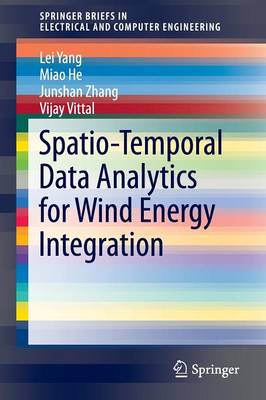SpringerBriefs in Electrical and Computer Engineering
2 total works
Spatio-Temporal Data Analytics for Wind Energy Integration
by Lei Yang, Miao He, Junshan Zhang, and Vijay Vittal
Published 1 January 2014
This SpringerBrief presents spatio-temporal data analytics for wind energy integration using stochastic modeling and optimization methods. It explores techniques for efficiently integrating renewable energy generation into bulk power grids. The operational challenges of wind, and its variability are carefully examined.
A spatio-temporal analysis approach enables the authors to develop Markov-chain-based short-term forecasts of wind farm power generation. To deal with the wind ramp dynamics, a support vector machine enhanced Markov model is introduced. The stochastic optimization of economic dispatch (ED) and interruptible load management are investigated as well.
Spatio-Temporal Data Analytics for Wind Energy Integration is valuable for researchers and professionals working towards renewable energy integration. Advanced-level students studying electrical, computer and energy engineering should also find the content useful.
A spatio-temporal analysis approach enables the authors to develop Markov-chain-based short-term forecasts of wind farm power generation. To deal with the wind ramp dynamics, a support vector machine enhanced Markov model is introduced. The stochastic optimization of economic dispatch (ED) and interruptible load management are investigated as well.
Spatio-Temporal Data Analytics for Wind Energy Integration is valuable for researchers and professionals working towards renewable energy integration. Advanced-level students studying electrical, computer and energy engineering should also find the content useful.
Social Group Utility Maximization
by Xiaowen Gong, Xu Chen, Lei Yang, and Junshan Zhang
Published 1 January 2014
This SpringerBrief explains how to leverage mobile users' social relationships to improve the interactions of mobile devices in mobile networks. It develops a social group utility maximization (SGUM) framework that captures diverse social ties of mobile users and diverse physical coupling of mobile devices. Key topics include random access control, power control, spectrum access, and location privacy.
This brief also investigates SGUM-based power control game and random access control game, for which it establishes the socially-aware Nash equilibrium (SNE). It then examines the critical SGUM-based spectrum access game, and pseudonym change game for personalized location privacy. The authors propose future work on extending the SGUM framework to negative social ties, to demonstrate relevance to security applications and span the continuum between zero-sum game (ZSG) and non-cooperative game (NCG).
Social Group Utility Maximization targets researchers and professionals working on mobile networks and social networks. Advanced-level students in electrical engineering and computer science will also find this material useful for their related courses.
This brief also investigates SGUM-based power control game and random access control game, for which it establishes the socially-aware Nash equilibrium (SNE). It then examines the critical SGUM-based spectrum access game, and pseudonym change game for personalized location privacy. The authors propose future work on extending the SGUM framework to negative social ties, to demonstrate relevance to security applications and span the continuum between zero-sum game (ZSG) and non-cooperative game (NCG).
Social Group Utility Maximization targets researchers and professionals working on mobile networks and social networks. Advanced-level students in electrical engineering and computer science will also find this material useful for their related courses.

